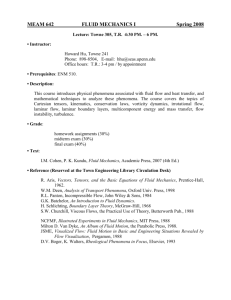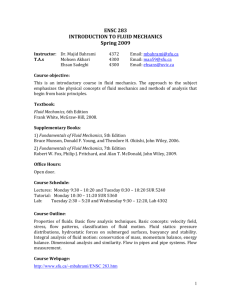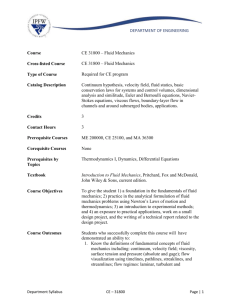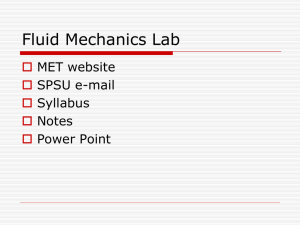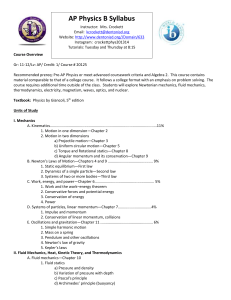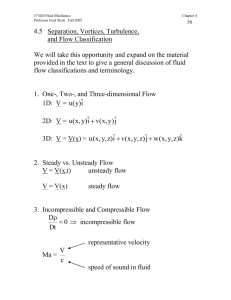Mechanical Engineering: Module 0
advertisement
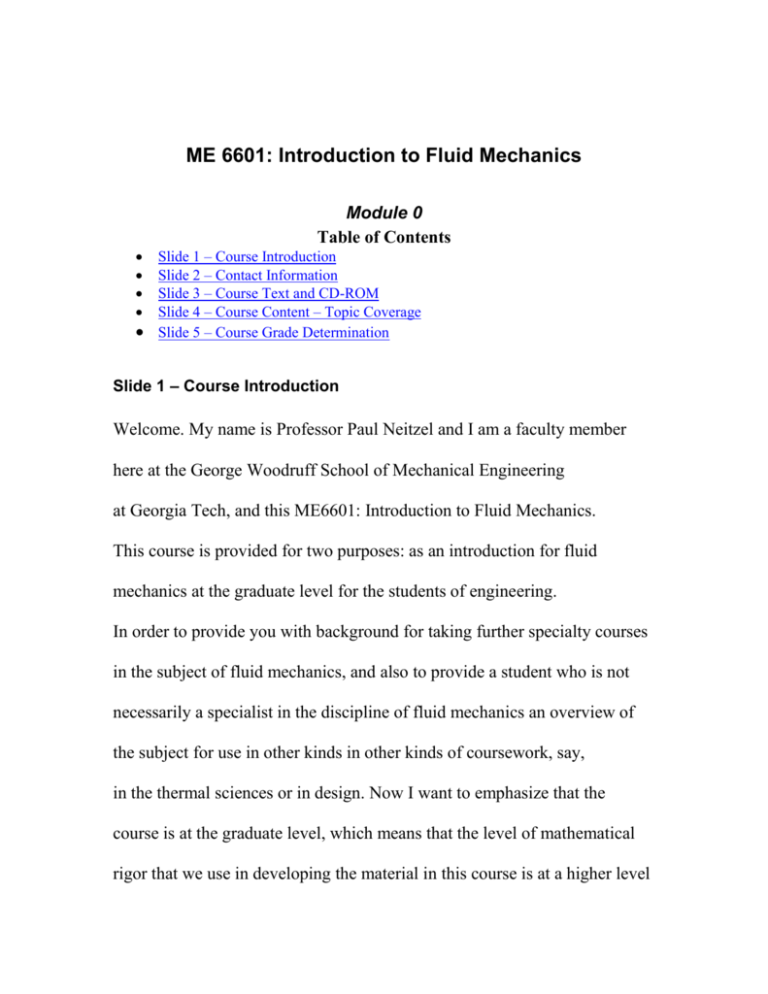
ME 6601: Introduction to Fluid Mechanics Module 0 Table of Contents Slide 1 – Course Introduction Slide 2 – Contact Information Slide 3 – Course Text and CD-ROM Slide 4 – Course Content – Topic Coverage Slide 5 – Course Grade Determination Slide 1 – Course Introduction Welcome. My name is Professor Paul Neitzel and I am a faculty member here at the George Woodruff School of Mechanical Engineering at Georgia Tech, and this ME6601: Introduction to Fluid Mechanics. This course is provided for two purposes: as an introduction for fluid mechanics at the graduate level for the students of engineering. In order to provide you with background for taking further specialty courses in the subject of fluid mechanics, and also to provide a student who is not necessarily a specialist in the discipline of fluid mechanics an overview of the subject for use in other kinds in other kinds of coursework, say, in the thermal sciences or in design. Now I want to emphasize that the course is at the graduate level, which means that the level of mathematical rigor that we use in developing the material in this course is at a higher level than typically encountered in undergraduate courses. Consequently, we are going to have to take a little bit of time at the beginning of the course to equip you with some of the tools you will need in order to follow the subsequent lectures. Slide 2 – Contact Information Some contact information: my name, mailing address, and telephone number for both voice and fax, and my email address are on this slide. You may also contact me through the course WebCT site. So if you need to get in touch with me, these are the usual means by which you can reach me, and I usually (typically) respond very quickly to email queries from students. So that may be the most effective way to get in touch with me during the course. Slide 3 – Course Text and CD-ROM There is a text for the coursework. It is titled Incompressible Flow, by Ron Panton, who is a professor at the University of Texas-Austin. It is published by Wiley-Interscience. We are using the second edition of the text. Although, I point out in the second book that the text is really meant as a reference and as a source for supplemental suggestive reading. The lecture notes that I’m going to be using have been developed over the course of about twenty-two years of teaching this subject, and are therefore a little bit different both a little bit in content and the approach taken to the course. Particularly, some of the mathematical notation taken will be different from what you see in the Panton text, and the level, or the approach taken to, certain subjects is also different from that which you will find in the text. But I think you will see that the text is a valuable one and is going to be a useful addition in you personal library. Slide 4 – Course Content – Topic Coverage In addition to the text, we are going to be using a brand new CD-ROM, entitled Multi-Media Fluid Mechanics, which was prepared by Homsy et al., and published in the year two-thousand by Cambridge University Press. This CD is a collection of video clips and snippets of material on various subjects in fluid mechanics, and from time to time I will point you to various points, various locations on that CD, for you to look at. We unfortunately cannot do video clips live during the lectures and so some of the video clips on this CD are useful and you will be able to look at them offline. Lets talk about the topic coverage we are going to be looking at this term. We are going to start out with some preliminary and introductory concepts. Under preliminaries, we’ll do an introduction to the subject of Cartesian tensors. You may not be familiar to Cartesian tensor notation, but it’s a notation which provides a lot of economy in terms of deriving some of our basic principles. And so if you have not seen Cartesian tensors before, you needn’t worry, everything we are going to be using in respect to the Cartesian tensor notation we shall derive in class and shall present in class. We’ll talk about some introductory concepts, about material and special frames of reference, and then we’ll move into kinematics, and spend a couple of modules on that subject. We then need to derive all the governing equations. We’ll be focusing our attention on incompressible flow in this course although we will do some compressible flow toward the end, and so for incompressible flow we are going to need the equation of conservation of mass and balance of linear momentum, Newton’s second law of motion. We’ll talk about the boundary conditions that need to be applied and other supplementary conditions such as initial conditions. Following that, we’ll begin our study of viscous flows, with a treatment of exact solutions. There are lots of exact solutions that are available to us in studying viscous flows, and we will catalog some of these. I’m not going to work them all out in detail. In fact, I will assign as homework for you to work out some of these solutions. After we finish with viscous flows, we’ll talk about inviscid flows, and in the category of inviscid flows we will be introducing Bernoulli’s equations, and we’ll talk about potential flow, potential flow being the flow of a perfect fluid. We may have some time to talk about water waves, but that has yet to be seen. Then we will investigate the subject of boundary layers. We’ll be talking about Laminar boundary layers first, we’ll briefly discuss integral methods that are applied to studying Laminar boundary layers, and then we will look at local methods which actually treat the full partial differential equation. No course of fluid mechanics at the introductory level would be complete without an introduction to turbulent flow. It’s a very difficult subject that warrants at least an entire course of its own, but we’ll be doing an introduction to the subject to provide you with some background to have an idea how turbulent flows get analyzed in practice. And then we’ll be briefly discussing compressible flow from the standpoint of so-called onedimensional gas dynamics. That’s about all we have time for in this particular course, and its going to round out our treatment of the material. Slide 5 – Course Grade Determination Now, the question students frequently ask is, “How is my grade going to be determined in this course?” Your grade is going to be determined from your performance on the homework assignments that are made, and on a final examination. I typically in a graduate level course do not give a midterm examination. I’d rather use the homework as some interim measure of your performance. The homework is going to be assigned somewhat irregularly, after certain modules have been completed. They won’t necessarily be assigned to accompany each of the modules. I have to wait until we’ve got a certain amount of material under our belts in order to make the homework assignment that would be meaningful for you. The purpose of the homework is not just to provide you with busywork, but to provide you with problems to work one that implement the lecture material. And the format for the final examination is always something that I do on the fly. It’s either going to be proctored, or its going to be take home. It depends on the kind of material, on the way we have been treating the material throughout the course of the term. However, I will announce well before the end of the semester whether the final examination for the course will be a proctored exam, and by that I mean what would be an in class exam for those students who are on campus, or whether it will be a take home examination that you will have to work on for yourself. It’s going to be in each student’s best interests, therefore, since there is some uncertainty as to how the final exam is going to be delivered, to prepare yourself, throughout your viewing of all these modules, as though the final examination were to be a proctored final exam, so that you might not have everything at your disposal for that examination. So that is it for the overview of the course, and we will begin with a study of the Cartesian tensors in the next module.

